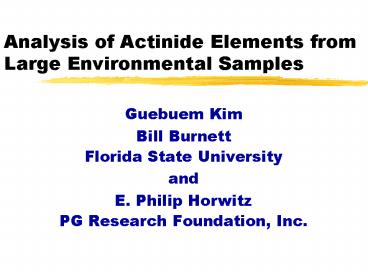Analysis of Actinide Elements from Large Environmental Samples - PowerPoint PPT Presentation
1 / 23
Title:
Analysis of Actinide Elements from Large Environmental Samples
Description:
'Fenton's Reagent' Diphonix. Ion Exchange Resin ... Oxidation by Fenton's Reagent. finished. Treatment: ... 'Fenton's Reagent' or O3 successfully oxidizes HEDPA ... – PowerPoint PPT presentation
Number of Views:89
Avg rating:3.0/5.0
Title: Analysis of Actinide Elements from Large Environmental Samples
1
Analysis of Actinide Elements from Large
Environmental Samples
- Guebuem Kim
- Bill Burnett
- Florida State University
- and
- E. Philip Horwitz
- PG Research Foundation, Inc.
2
Need for Large Volumes
- Achieve low MDA's for environmental monitoring
- Specialized scientific studies often require
large volumes to obtain necessary sensitivity,
e.g., Am/Pu in seawater, global fallout in recent
soils
3
Analytical Challenges
- Preconcentration of actinides from natural water
samples may require handling up to 100-400 liters - Large (5-10 grams or more) soil/sediment samples
may require difficult and lengthy dissolution
procedures - Separation chemistry, especially from large
soil/sediment samples, suffers from matrix
effects.
4
Actinides in Natural Waters
Precipitate MnO2
pH 2 KMnO4 NaOH, pH 8 MnCl2
10's - 100's liters tracers
2M HCl/NH2OH.HCl 50 mg Fe NaNO2 pH 6-7
Precipitate Fe(OH)3
- Resins
- UTEVA
- TRU
Separation
- Am, Pu, etc.
- alpha spectrometry
- ICP-MS
5
Marine Environment LaboratoryMonaco
6
Am/Pu from 200-L Seawater
Supernatant seawater transferred from one plastic
tank to another via pumping this will be used
for 90Sr and 137Cs.
MnO2 suspension withdrawn from bottom of
conical-shaped plastic tanks processed for Am
and Pu.
7
Irish Sea Water Results
8
Soils and Sediments
Dissolution/ Leaching
tracers Fe(OH)3 ppt 0.1M HCl-0.3M HF, AA
0.5M HEDPA
Diphonix
"Matrix"
- Ozonation
- Fentons Reagent
oxidation
H3PO4
- Resins
- TRU
- TEVA
- UTEVA
- Am, Pu, etc.
- alpha spectrometry
- ICP-MS
one or more
Separation
9
DiphonixIon Exchange Resin
- Features of Diphonix
- diphosphonic sulfonic acid groups
- polystyrene/divinylbenzene matrix
- extremely high actinide retention, low common ion
adsorption - tolerant to HF
10
Actinide Retention on Diphonix Resin
Diphonix Resin shows high retention for all
Actinides
11
Adsorption of 241Am
Adsorption of actinides highest at pH 1-2
12
HEDPA
- 1-hydroxyethane-1, 1-diphosphonic acid
- Molecular weight 206.03
- Elution sequence Th(IV) Pu(IV) gt U(VI) gt
Am(III) - Reagent-grade expensive (Fluka 50 g 165)
option to purify industrial grade (Albright
Wilson BRIQUEST ADPA-60AW U)
13
ElutionHEDPAAcid DependencyCurves
Indicates that actinides should elute easily at
concentrations 0.5M
14
Elution of Am
15
HEDPA Destruction via Ozone
20-mL elution was diluted to 70 mL, H2O2 added
(0.5M), pH adjusted to 9.0 with NaOH, and samples
ozonated for variable lengths of time
16
Ozonation Process
sample
Ozone delivered from an ozone generator via a gas
diffusion stone oxidizes the HEDPA
17
Oxidation by Fentons Reagent
finished
Treatment 40 mL 0.5M HEDPA 1 mL HNO3 40 mL
H2O2 0.17 g Fe(NH4)2(SO4)26H2O Temperature
90oC
H2O2 Fe2 OH OH- Fe3
18
Actinide Separations
Sample (3M HNO3, 0.7M Al(NO3)3, FS, AA)
TRUResin tolerates high PO4
Final clean-ups Am/Ln on TEVA U on UTEVA
19
Sensitivity to PO4
TRU.Resin
UTEVA.Resin
20
Preliminary Tests
Am-241 and Th-234 spiked samples. Matrix
HNO3/HCl leach of 10-g NIST Rocky Flats II soil
21
Standard Samples Yields
- Samples (n7)
- 3 EML soils
- 2 IAEA sediments
- 2 Fe-rich soils
5 intercomparison samples and 2 Fe-rich samples
run through entire procedure and analyzed for Am,
Pu, U, and Th. 10-gram samples were leached with
HNO3/HCl.
22
Standard Samples Results
Table 1 EML and IAEA intercomparison values.
23
Summary
- Uptake of actinides onto Diphonix from complex
matrices is very efficient - 0.5M HEDPA easily elutes actinides
- Fentons Reagent or O3 successfully oxidizes
HEDPA - Separations starting with TRUResin prevent PO4
interference





























